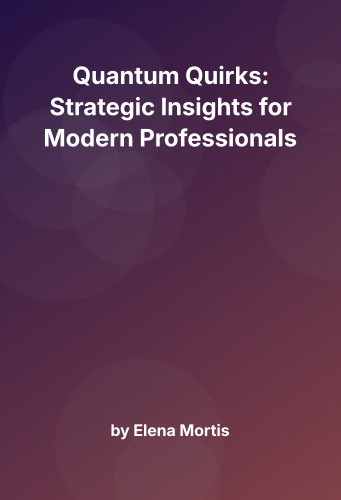Core Frameworks and Concepts
In “Quantum Quirks,” Elena Mortis presents a series of frameworks that harness quantum principles to reshape business strategy and leadership. These frameworks are designed to aid professionals in navigating the increasingly complex and unpredictable business landscape.
Quantum Mindset Framework
Mortis introduces the Quantum Mindset Framework, which encourages professionals to embrace uncertainty as an inherent aspect of strategic planning. This framework is structured around three key components: Strategic Superposition, Adaptive Observation, and Dynamic Entanglement.
1. Strategic Superposition
This concept parallels the quantum principle of superposition, where particles exist in multiple states simultaneously. Mortis suggests that organizations adopt a strategic superposition by developing multiple potential strategies and maintaining flexibility until determining which path to pursue. This approach mirrors Jim Collins’s ideas in “Good to Great,” where companies are encouraged to confront the brutal facts while maintaining an unwavering faith in their end goals.
Example: A tech company might simultaneously explore both hardware innovations and software solutions, waiting to see which garners more market traction before fully committing resources.
2. Adaptive Observation
Drawing on the observer effect, Mortis argues that the way leaders observe and interact with their environment influences business outcomes. Adaptive Observation involves regularly assessing market trends and internal dynamics to adjust strategies accordingly. This is akin to the agile methodologies discussed in “The Lean Startup” by Eric Ries, where continuous feedback loops inform iterative development processes.
Example: A retail brand might deploy small-scale marketing campaigns to test consumer responses before launching a full-scale product rollout.
3. Dynamic Entanglement
Dynamic Entanglement emphasizes the importance of interconnectedness and collaboration, similar to how entangled particles affect each other. Mortis advocates for fostering networks within and outside the organization to enhance resilience and innovation. This echoes the themes in “Team of Teams” by General Stanley McChrystal, where decentralized networks are seen as crucial for adaptability in complex environments.
Example: A multinational corporation can create cross-functional teams that include members from different departments and regions, ensuring diverse perspectives and collaborative problem-solving.
Entangled Leadership Model
Mortis’s Entangled Leadership Model revolutionizes traditional hierarchies by promoting decentralized decision-making and empowering employees. This model is structured in three layers: Collaborative Networks, Empowered Autonomy, and Continuous Feedback.
1. Collaborative Networks
This layer emphasizes building a web of interconnected teams that share information and resources freely. It aligns with the concepts in “The Starfish and the Spider” by Ori Brafman and Rod A. Beckstrom, where decentralized organizations thrive by distributing leadership.
2. Empowered Autonomy
Empowered Autonomy encourages individuals at all levels to take initiative and make decisions. This empowerment fosters innovation, akin to the management principles in “Drive” by Daniel Pink, which highlight autonomy as a key motivator.
3. Continuous Feedback
Continuous Feedback is essential for maintaining alignment and growth within the entangled organization. Mortis suggests implementing regular check-ins and reviews to ensure everyone is moving towards common goals, much like the feedback loops in “Radical Candor” by Kim Scott.
Real-World Application: A tech startup might use this model to create agile teams that can pivot quickly in response to customer feedback, with leaders facilitating rather than directing innovation.
Key Themes
1. Embracing Uncertainty: Quantum Thinking in Business Strategy
Mortis challenges the traditional deterministic models of business strategy by advocating for a quantum mindset that embraces uncertainty. By doing so, organizations can capitalize on unpredictability as a driver of innovation.
Example: In a volatile market, a company may keep multiple product development paths open, allowing them to shift focus rapidly based on emerging trends.
2. The Entangled Organization: Collaboration and Interconnectivity
The book emphasizes the importance of interconnected teams and networks, drawing a parallel to quantum entanglement. Mortis argues that breaking down silos and fostering cross-functional collaboration is crucial for success in the digital age.
Case Study: A global tech company implemented cross-departmental workshops to enhance communication, resulting in a more cohesive product development cycle.
3. Quantum Leaps: Innovation and Disruptive Change
Mortis likens significant organizational changes to quantum leaps, advocating for bold moves to stay competitive. This requires a culture that encourages risk-taking and tolerates failure as a part of the innovation process.
Comparison: Similar to the “Blue Ocean Strategy” by W. Chan Kim and Renée Mauborgne, Mortis suggests that organizations should venture into uncharted territories to create new market spaces.
4. The Observer Effect: Leadership and Influence
The observer effect in quantum mechanics is used as a metaphor for the impact of leadership on organizational culture. Mortis emphasizes the need for leaders to be aware of their influence and encourages practices that promote transparency and authenticity.
Analogy: Just as observing a particle can change its behavior, a leader’s actions and presence can significantly shape the organization’s dynamics.
5. Quantum Ethics: Navigating the Digital Transformation
In the realm of digital transformation, Mortis highlights the ethical implications of technological advancements. She urges professionals to adopt a quantum ethical framework that continuously evaluates the societal and environmental impacts of their digital initiatives.
Case Study: A tech firm implemented an ethics review board to oversee AI developments, ensuring alignment with broader social values.
Final Reflection
“Quantum Quirks” presents a visionary approach to modern business strategy by integrating quantum principles into practical frameworks. Mortis’s work challenges professionals to rethink traditional models and embrace complexity as a source of innovation. By synthesizing insights from quantum mechanics, leadership, and strategic planning, Mortis offers a comprehensive guide for navigating today’s dynamic business environment.
The book’s emphasis on embracing uncertainty, fostering interconnectedness, and prioritizing ethical considerations resonates across domains such as leadership, design, and organizational change. Just as leaders from various fields, like those discussed in “Leaders Eat Last” by Simon Sinek, prioritize trust and collaboration, Mortis’s frameworks encourage a holistic approach to strategy that values adaptability and resilience.
Ultimately, “Quantum Quirks” inspires professionals to become “quantum professionals” who are adept at navigating complexity and uncertainty. By adopting a quantum mindset, organizations can lead with agility, interconnectedness, and ethical integrity, driving transformative success in the ever-evolving business landscape.

